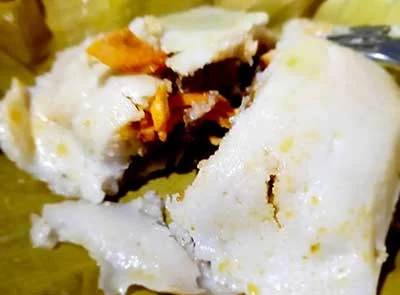[CULTURE] A Tale of Two Tamales: Ibaan and Lipa
At the public market of the city of Lipa in Batangas, ask to be shown where you can buy tamales and you will likely be directed to a seller of this green suman (a rice cake wrapped in banana leaf) which in other localities people will refer to as “suman sa lihiya” (rice cake in lye). We shall return to this matter subsequently.
Elsewhere in Batangas, what people call tamales is also a rice cake wrapped in banana leaf, but that is just about where the similarity ends. In other towns, tamales is a steamed rice cake with an outer coating of fine-textured ground glutinous rice and filled with shredded chicken or ground meat, slices of boiled or salted egg and pre-cooked ground rice and peanuts1.
At the public market in Lipa City, if you want this instead, you have to say tamales-Ibaan, albeit Ibaan owns no proprietary rights to the tamales. The name of the town is merely appended to indicate where the tamales was made; and of course, Ibaan is less than 15 kilometers from Lipa as the crow flies.
Local versions of the tamales — which is by no means made only in Batangas2 — appear to be adaptations of the Mexican tamale. Although History books all say that the Philippine Islands were under Spanish colonial rule for more than three centuries, in fact much of the governance was conducted through Mexico, another of its former colonies.
Hence, Mexican influence on Philippine culture is evident not just in local cuisine but also in other aspects of culture such as religion, language and the arts.
But to get back to the Mexican tamale, it is, in fact, an ancient delicacy that predates even Spanish colonial rule in Mexico all the way back to the time of the Aztecs. Traditionally, the Mexican tamale was a tortilla made by “cooking the [corn] kernels with lime, then grinding the dough on a stone slab3.”
That the Filipino tamales uses dough made from rice instead of corn and banana leaves as wrappings instead of corn husks is probably due merely to a matter of historical practicality. Corn was not introduced in the Philippines until the late 1560s5 and widespread cultivation would not come until much later.
In contrast, both rice and bananas would have been readily available everywhere in the country early during the Spanish colonial regime and would have been obvious substitutes for corn and its husk when some enterprising cook decided to make a local adaptation of the Mexican tamale.
Meanwhile, the other rice cake people call the tamales in Lipa has no similarity to the Mexican tamale at all. As mentioned, it is called in other places as the “suman sa lihiya” (lye being “lejia” in Spanish).
This rice cake gets its sticky or gooey texture from lye water, which in the old days was made with ashes extracted from, among other things, the uray weed or spiny amaranth6. It has no filling and, in fact, to enhance its flavor, coconut jelly is applied to its top side before it is eaten.
It is not really known why this rice cake is called tamales in Lipa, but some locals conjecture that it is probably because of the banana leaf wrapping.
2 In Pampanga, for instance, the tamales is called the “bubuto” (Kapampangan). “Filipino Tamales,” by Lalaine Manalo, initially posted 5 May 2016, updated 20 May 2019. Online at Kawaling Pinoy.
3 “The Aztecs,” by Richard F. Townsend, revised edition published 2000 in London.
4 “Tamale,” Wikipedia.
5 “The Rise of Maize as a Major Crop Plant in the Philippines,” by J. E. Spencer, published 1975 in the Journal of Historical Geography.
6 “Uray,” online at Philippine Medicinal Plants.



